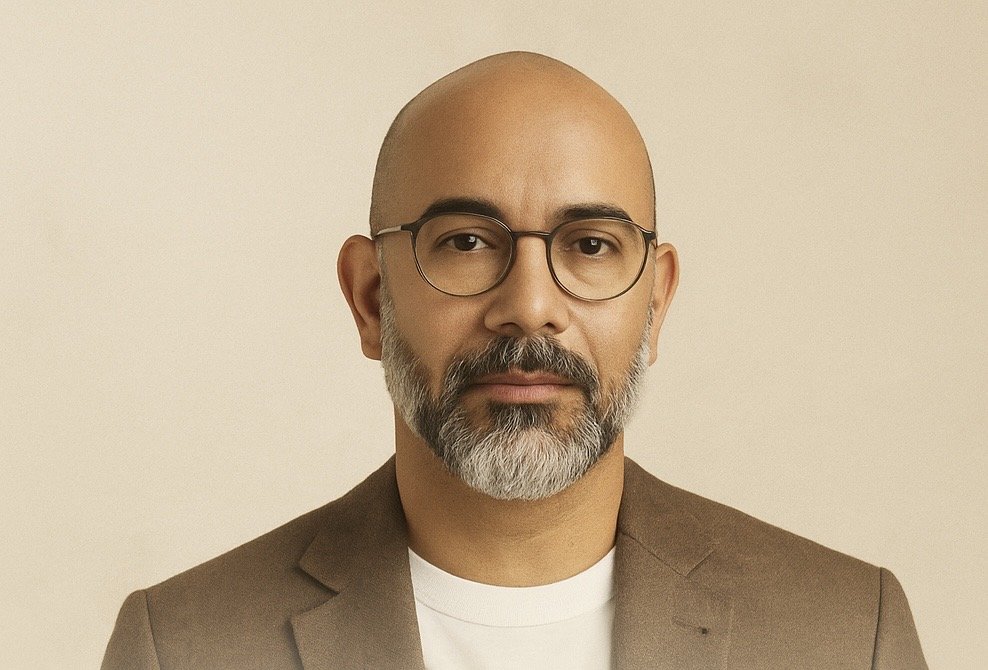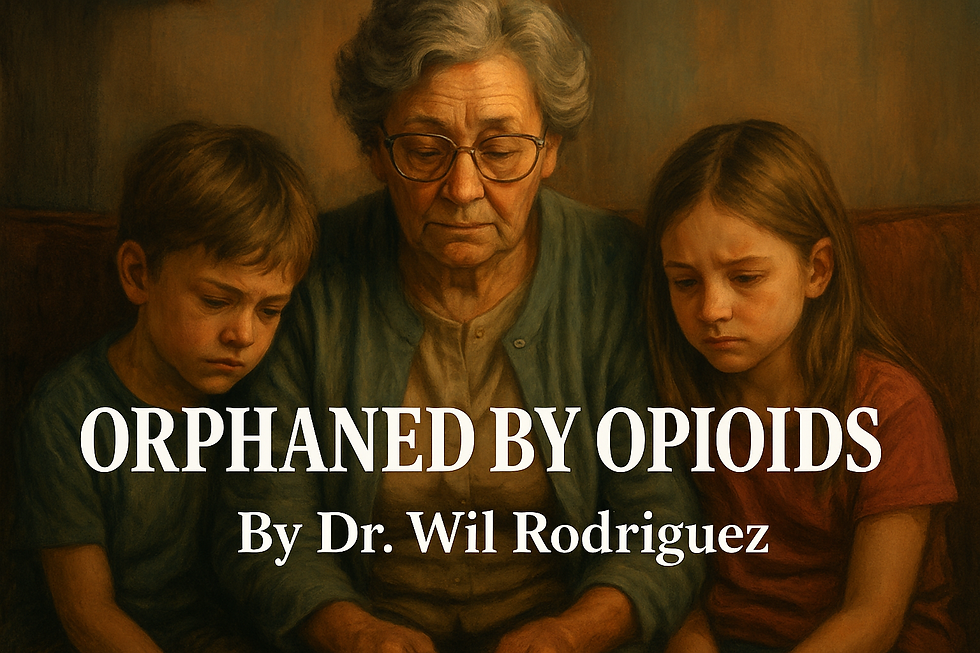Orphaned by Opioids: The Hidden Generation of 2.7 Million American Children
- Dr. Wil Rodriguez

- 3 days ago
- 7 min read
An Investigation by Dr. Wil Rodriguez | Tocsin Magazine

Opening: The Weight of Morning
Martha Johnson’s hands shake as she pours cereal into Tyler’s bowl. At 74, her arthritis screams with each movement, but the 8-year-old needs breakfast before school. This isn’t how she imagined her golden years. Three years ago, her daughter Sarah overdosed in a McDonald’s bathroom in Huntington, West Virginia, leaving Tyler to wonder why Mommy never came home from getting Happy Meals.
Martha is not alone. She’s part of an invisible army of 2.65 million grandparents across America who’ve become accidental parents again, casualties of an opioid epidemic that has fundamentally altered the American family. They are raising children they never expected to raise, with resources they don’t have, in a system that has largely forgotten they exist.
The Great Unraveling
Drive through any small town in Kentucky, Ohio, or West Virginia, and you’ll see them: elderly hands gripping young ones at school pickup, gray-haired figures hunched over homework at kitchen tables, grandparents sleeping in recliners because their beds now belong to grandchildren having nightmares about parents who disappeared into the grip of addiction.
This is America’s hidden demographic crisis. While politicians debate border security and economists analyze inflation, an entire generation of children is being raised by people who should be enjoying retirement. The numbers tell only part of the story: 44% of new foster care cases in Alabama stem from parental substance abuse. In some counties, the percentage climbs above 60%. But behind each statistic lives a Martha Johnson, stretched beyond her limits, loving beyond her capacity.
The phenomenon represents a seismic shift from previous drug crises. During the crack epidemic of the 1980s and 90s, kinship care arrangements primarily affected Black urban families. Today’s opioid crisis has devastated white, rural, and suburban communities, creating a different kind of extended family structure that social services were never designed to support.
When Retirement Becomes Parenthood Again
In Pikeville, Kentucky, 68-year-old Robert Hayes juggles chemotherapy appointments with his granddaughter Emma’s soccer practice. His daughter died of a fentanyl overdose two years ago, leaving him to navigate the bewildering world of Common Core math and TikTok while fighting his own battle against lung cancer. “I thought I’d done my job raising kids,” he says, exhaustion etched in every line of his face. “Turns out, I was just getting started.”
The physical toll is crushing. Bodies that ache with decades of wear are suddenly chasing toddlers, lifting car seats, staying up all night with sick children. Fixed incomes stretched thin by prescription copays now must accommodate school supplies, sports fees, and the endless appetite of growing children. Social Security checks that once provided modest comfort now barely cover rent and groceries for expanded households.
Beyond the financial strain lies an emotional complexity that support groups struggle to address. These grandparents grieve their adult children while simultaneously trying to fill the parental void. They must explain addiction to confused grandchildren who ask why Daddy doesn’t visit anymore, why Mommy chose drugs over them. The children, meanwhile, carry trauma that manifests in ways that would challenge professional therapists, let alone grandparents who never expected to parent again.
The Children’s Silent Struggle
Sixteen-year-old Ashley Martinez hasn’t seen her mother in three years. She lives with her grandmother in a cramped apartment in Springfield, Massachusetts, sharing a bedroom with her two younger cousins whose father is also lost to addiction. Ashley excels in school despite everything, but her guidance counselor notices the exhaustion in her eyes, the way she mothers her younger cousins, the careful way she rations her emotional energy.
These children occupy a unique space in the grief spectrum. Their parents aren’t dead, but they might as well be. The psychological term is “ambiguous loss,” and it’s particularly devastating for developing minds. Unlike children who lose parents to death or divorce, these children live with the constant possibility of reunion, the false hope that feeds disappointment month after month, year after year.
Teachers report a phenomenon they’re calling “grandfamily fatigue” in their classrooms. Children raised by grandparents often struggle with technology gaps, miss field trips due to transportation issues, and arrive at school having eaten dinner leftovers for breakfast because their elderly caregivers can’t manage the morning routine. The academic achievement gaps in heavily affected communities continue to widen, creating long-term educational consequences that will ripple through generations.
System Failure on a Grand Scale
The child welfare system, already strained beyond capacity, has essentially outsourced the opioid crisis to America’s grandparents. Social workers celebrate kinship placements because they keep children out of overcrowded foster homes, but the support structures that help traditional foster families simply don’t exist for relative caregivers.
Margaret Chen, a family court judge in Ohio, sees the legal limbo daily in her courtroom. “We have grandparents caring for children for years without legal guardianship because the biological parents surface periodically, clean for a few months, then disappear again,” she explains. “Meanwhile, the grandmother can’t enroll the child in school, can’t authorize medical treatment, can’t make the basic decisions that parenthood requires.”
The financial disparities are stark. Foster families receive monthly stipends, healthcare coverage, and support services. Grandfamilies receive prayers and good wishes. While foster care provides an average of $500-800 per child monthly, along with Medicaid coverage, grandparents often receive nothing beyond whatever family assistance programs they can navigate. The result is a two-tiered system where professional foster parents are compensated while family members are expected to sacrifice out of love alone.
Communities Transformed
In small towns across Appalachia and the Midwest, the demographic shift is visible everywhere. Elementary school parent-teacher conferences have become grandparent-teacher conferences. Church nurseries that once relied on young mothers now depend on women in their 70s. Community centers have started offering “Grandparents as Parents” support groups that fill to capacity every week.
Dr. Susan Chen, a pediatrician in rural Kentucky, has watched her practice evolve. “I’m now counseling 65-year-old women about potty training and explaining adolescent development to men who raised their own children in a completely different era,” she says. Her waiting room reflects the change: elderly patients with their blood pressure medications sitting next to the same elderly patients with their grandchildren’s immunization records.
The economic implications extend beyond individual families. Grandparents who planned to reduce their working hours instead find themselves re-entering the workforce or delaying retirement. Others exhaust their savings on childcare expenses they never anticipated. The result is a generation of seniors with depleted resources facing their own aging needs while still responsible for dependent children.
Glimmers of Hope in Dark Places
Despite systemic neglect, innovative programs are emerging from the grassroots level. In Montgomery, Alabama, a coalition of grandfamilies successfully lobbied for a portion of the state’s opioid settlement funds to create the first dedicated support program for kinship caregivers. The $280,000 allocation provides modest monthly supplements, legal aid, and respite care services.
Churches across the South have become unlikely social service providers, offering everything from car seat installation to homework help. The New Hope Baptist Church in Jackson, Mississippi, runs a weekly “Grands and Grands” program where volunteers help elderly caregivers navigate everything from smartphone apps to college applications.
These community-driven solutions highlight what’s possible when society acknowledges the scope of the crisis. Yet for every success story, thousands of grandfamilies struggle in isolation, unaware that help exists or too proud to ask for it.
The Looming Crisis
Perhaps the most troubling aspect of this story is what happens next. The grandparents currently serving as primary caregivers are aging rapidly under stress. Actuarial tables suggest that many won’t live to see their grandchildren reach adulthood. What happens to these children when their elderly caregivers can no longer provide care?
Martha Johnson, still pouring Tyler’s morning cereal, thinks about this daily. At 74, she worries about her own health, her limited savings, her ability to be there for Tyler’s high school graduation, his wedding, his children. “I love this boy more than life itself,” she says, “but I’m terrified of what happens to him when I’m gone.”
The children sense this anxiety. They mature faster than their peers, taking on household responsibilities and emotional burdens that should belong to adults. They learn early that the adults in their lives are fragile, temporary, overwhelmed. This awareness shapes their worldview in ways that researchers are only beginning to understand.
A Nation’s Moral Reckoning
This crisis represents more than a policy failure; it’s a moral test of American values. We claim to prioritize family and children, yet we’ve created a system that abandons both. We celebrate grandparents in greeting cards and Facebook posts while ignoring their sacrifice in real life. We wring our hands about the opioid epidemic while overlooking its most vulnerable victims: the children left behind.
The solutions exist. They require political will, financial investment, and a fundamental recognition that kinship care is not a free alternative to traditional foster care but a distinct form of family structure that deserves dedicated support. The opioid settlement funds could provide resources. Policy changes could eliminate legal barriers. Community programs could offer practical support.
But first, America must acknowledge that Martha Johnson and Tyler exist, that their story is replicated in millions of homes across the country, and that their future depends on choices we make today. The hidden generation of opioid orphans is hidden no longer. The question is whether we have the courage to see them and the compassion to act.
In the end, this story isn’t really about opioids or addiction or even child welfare policy. It’s about love: the fierce, sacrificial love of grandparents who stepped up when everything else fell apart, and the resilient love of children who learned to find hope in the most unlikely places. Their love shouldn’t have to be enough. But too often, it’s all they have.
📊 The Numbers Behind the Crisis
2.7 million children in the United States live in households headed by grandparents due to parental substance abuse.
44% of new foster care cases in Alabama are linked to parental drug use, with some counties exceeding 60%.
The average foster care stipend is $500–$800 per month, while most grandparents receive no direct financial assistance.
In West Virginia, 1 in 5 children lives in a grandparent-led household — the highest rate in the nation.
Opioids are implicated in 70% of overdose deaths in the U.S., with a rising proportion of victims being parents of minor children.
Kinship caregivers are twice as likely to live in poverty compared to other caregivers.
📦 Reflection Box
“When a society shifts its parenting burden to its oldest citizens, it reveals the depth of its moral fracture. The opioid crisis is not just about addiction — it is about what we choose to save when everything is burning. Will we leave the smallest survivors to navigate alone, or will we rebuild the village they deserve?” — Dr. Wil Rodriguez
✉ Invitation to Join
TOCSIN Magazine
This investigation is part of TOCSIN Magazine’s commitment to tell the stories the headlines forget — voices on the margins, communities in crisis, and the quiet resilience of those who carry the weight of our collective failures.
📍 Read. Reflect. Respond.
🔗 Subscribe today and be part of the movement to shine a light on the stories that matter most: tocsinmag.com







Comentários